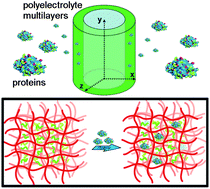3d localization and diffusion of proteins in polyelectrolyte multilayers†
Abstract
The interaction of diverse biomaterials with surfaces is more crucial than ever for biomedical applications to ensure efficiency and reproducibility. Very interesting surface materials are micrometer-thick polyelectrolyte multilayers. Not only their surface but also the bulk can be loaded with biomaterials like


 Please wait while we load your content...
Please wait while we load your content...